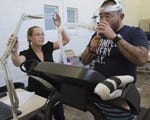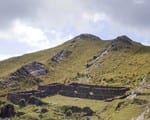“Power Plays,” on Dallas campus April 25-26, is SMU Geothermal Laboratory’s eighth international energy conference and workshop
SMU’s renowned SMU Geothermal Laboratory will host its eighth international energy conference April 25-26 on the Dallas campus, focused on using the oilfield as a base for alternative energy production through the capture of waste heat and fluids.
In addition to oil and gas field geothermal projects, experts will discuss coal plant conversion for geothermal production, the intersection of geothermal energy and desalination, and large-scale direct use of the energy source produced by the internal heat of the earth.
“Power Plays” begins with an opening reception and poster session from 5:30 p.m. – 8 p.m. Monday, April 25, followed by a daylong program of speakers and presentations Tuesday, April 26. Conference details are available here. Walk-up registration is available at the conference site, the Collins Center at 3150 Binkley Avenue, Dallas, 75205.
The technology that is the primary focus of the conference takes advantage of an existing resource frequently considered a nuisance – wastewater produced by oil and gas wells during extraction. As a well ages it will typically produce more water and less oil or gas over time, which raises the cost of production. Where the produced wastewater is hot enough, and the water flow rate is sufficient, specially designed turbines can draw geothermal energy from the wastewater.
That “bonus” geothermal energy can be used to either generate electricity to operate the oil field equipment and lower the cost of production, sell the electricity directly to the power grid or — more likely — to nearby industry users seeking a highly secure electrical source.
“Initial demonstration projects have taught us a great deal about the complexities of transitioning an oil or gas well to geothermal energy production,” said Maria Richards, director of the SMU Geothermal Lab. “Collaboration continues between the oil and gas industry and the geothermal community, and this conference is the place to hear about the technology, business models and legislation that all play a role in developing geothermal resources. We are confident that geothermal energy production will one day be the norm for an aging oil and gas field.”
The appearance of AltaRock Energy’s Susan Petty to discuss “Transitioning Coal to Geothermal: Baseload Renewable Power With No CO2” will be the first examination of this type of geothermal production at the SMU conference, Richards said, adding that she is pleased to see geothermal technology being combined with other energy systems, from large scale solar operations to electricity generated by on-site flare gas.
“The small surface footprint of geothermal energy makes it a desirable player for developers looking to maximize all possible resources on their site,” Richards said.
SMU’s Geothermal Lab team members are leaders of academic data sources for exploration and assessment of existing and potential geothermal resources. SMU scientists developed the Geothermal Map of North America and built one of the primary nodes of the National Geothermal Data System (NGDS) for temperature and oil/gas data. Their research efforts include over 50 years of continuous thermal data collection and is viewed by the community as an important first-stage resource used in determining the potential for geothermal energy production in the United States.
The SMU Geothermal Lab has been the recipient of approximately $10 million in research grants from a variety of sources, including the Department of Energy, the National Science Foundation, the Texas State Energy Conservation Office, Google.org and private industry. — Kim Cobb
SMU is a nationally ranked private university in Dallas founded 100 years ago. Today, SMU enrolls nearly 11,000 students who benefit from the academic opportunities and international reach of seven degree-granting schools. For more information see www.smu.edu.
SMU has an uplink facility located on campus for live TV, radio, or online interviews. To speak with an SMU expert or book an SMU guest in the studio, call SMU News & Communications at 214-768-7650.

 NASA data leads to rare discovery: Earth’s moon wandered off axis billions of years ago
NASA data leads to rare discovery: Earth’s moon wandered off axis billions of years ago Good news! You’re likely burning more calories than you thought
Good news! You’re likely burning more calories than you thought New look at Pizarro’s conquest of Inca reveals foot soldiers were awed by empire’s grandeur
New look at Pizarro’s conquest of Inca reveals foot soldiers were awed by empire’s grandeur Charity, social justice and earth-friendly activism replace big houses, diamond rings and ostentatious living for status seekers
Charity, social justice and earth-friendly activism replace big houses, diamond rings and ostentatious living for status seekers National Center for Arts Research white paper counters findings of the Devos Institute Study on Culturally Specific Arts Organizations
National Center for Arts Research white paper counters findings of the Devos Institute Study on Culturally Specific Arts Organizations “There is more than enough heat below our feet to take all the state’s industrial consumption off the existing transmission grid,” says Maria Richards, program coordinator for the
“There is more than enough heat below our feet to take all the state’s industrial consumption off the existing transmission grid,” says Maria Richards, program coordinator for the 
